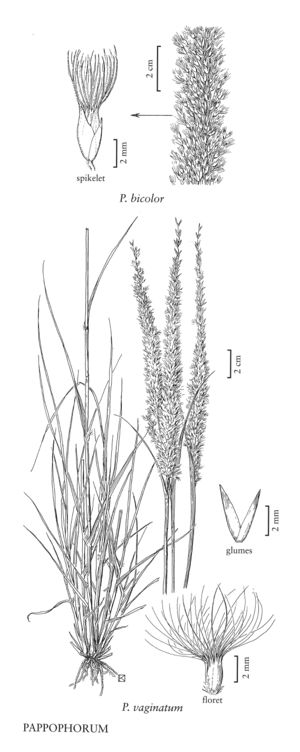Difference between pages "Cirsium nuttallii" and "Pappophorum bicolor"
FNA>Volume Importer |
FNA>Volume Importer |
||
| Line 1: | Line 1: | ||
{{Treatment/ID | {{Treatment/ID | ||
| − | |accepted_name= | + | |accepted_name=Pappophorum bicolor |
| − | |accepted_authority= | + | |accepted_authority=E. Fourn. |
| − | |publications= | + | |publications= |
| − | + | |common_names=Pink pappusgrass | |
| − | + | |basionyms= | |
| − | + | |synonyms= | |
| − | + | |hierarchy=Poaceae;Poaceae subfam. Chloridoideae;Poaceae tribe Pappophoreae;Pappophorum;Pappophorum bicolor | |
| − | |common_names= | + | |hierarchy_nav=<div class="higher-taxa"><div class="higher-taxon"><small>family</small>[[Poaceae]]</div><div class="higher-taxon"><small>subfamily</small>[[Poaceae subfam. Chloridoideae]]</div><div class="higher-taxon"><small>tribe</small>[[Poaceae tribe Pappophoreae]]</div><div class="higher-taxon"><small>genus</small>[[Pappophorum]]</div><div class="higher-taxon"><small>species</small>[[Pappophorum bicolor]]</div></div> |
| − | |basionyms= | + | |volume=Volume 25 |
| − | + | |mention_page= | |
| − | + | |treatment_page=page 286 | |
| − | |||
| − | |||
| − | |||
| − | |synonyms= | ||
| − | |||
| − | |||
| − | |||
| − | |hierarchy= | ||
| − | |hierarchy_nav=<div class="higher-taxa"><div class="higher-taxon"><small>family</small>[[ | ||
| − | |volume=Volume | ||
| − | |mention_page= | ||
| − | |treatment_page=page | ||
}}<!-- | }}<!-- | ||
| − | --><span class="statement" id="st-undefined" data-properties=""><b> | + | --><span class="statement" id="st-undefined" data-properties=""><b>Culms </b>30-80(100) cm. <b>Sheaths</b> mostly glabrous, apices with a tuft of hairs on either side; ligules about 1 mm; blades 10-20(30) cm long, 2-5 mm wide, flat to involute. <b>Panicles</b> 12-20 cm, narrow but usually with some slightly spreading branches, pink- or purple-tinged. <b>Spikelets</b> with the lower 2 or 3 florets bisexual, distal 1-2 florets sterile. <b>Glumes</b> 3-4 mm, thin, glabrous, apices acute or minutely notched and mucronate; lemmas somewhat firm, usually faintly 7-veined, with 11-15 awns; lowest lemma bodies 3-4 mm, midveins and margins pubescent from the base to about midlength, awns about 1.5 times as long as the lemma bodies; paleas subequal to the lemma bodies or slightly longer. <b>Caryopses</b> about 2 mm. <b>2n</b> = 100.</span><!-- |
-->{{Treatment/Body | -->{{Treatment/Body | ||
| − | + | |distribution=N.Y.;Tex. | |
| − | + | |discussion=<p><i>Pappophorum bicolor</i> grows in open valleys, road right of ways, and grassy plains in Texas and northern Mexico. A report for Arizona (Mearns 1175) was apparently due to mixed labels. There have been no subsequent reports of the species from the state.</p> | |
| − | |||
| − | |distribution= | ||
| − | |discussion=<p><i> | ||
|tables= | |tables= | ||
|references= | |references= | ||
| Line 40: | Line 25: | ||
-->{{#Taxon: | -->{{#Taxon: | ||
| − | name= | + | name=Pappophorum bicolor |
|author= | |author= | ||
| − | |authority= | + | |authority=E. Fourn. |
|rank=species | |rank=species | ||
|parent rank=genus | |parent rank=genus | ||
| − | |synonyms= | + | |synonyms= |
| − | |basionyms= | + | |basionyms= |
| − | |family= | + | |family=Poaceae |
| − | + | |distribution=N.Y.;Tex. | |
| − | |||
| − | |||
| − | |distribution= | ||
|reference=None | |reference=None | ||
| − | |publication title= | + | |publication title= |
| − | |publication year= | + | |publication year= |
|special status= | |special status= | ||
| − | |source xml=https://jpend@bitbucket.org/aafc-mbb/fna-data-curation.git/src/f6b125a955440c0872999024f038d74684f65921/coarse_grained_fna_xml/ | + | |source xml=https://jpend@bitbucket.org/aafc-mbb/fna-data-curation.git/src/f6b125a955440c0872999024f038d74684f65921/coarse_grained_fna_xml/V25/V25_933.xml |
| − | |tribe= | + | |subfamily=Poaceae subfam. Chloridoideae |
| − | |genus= | + | |tribe=Poaceae tribe Pappophoreae |
| − | |species= | + | |genus=Pappophorum |
| + | |species=Pappophorum bicolor | ||
}}<!-- | }}<!-- | ||
| − | -->[[Category:Treatment]][[Category: | + | -->[[Category:Treatment]][[Category:Pappophorum]] |
Revision as of 20:25, 24 September 2019
Culms 30-80(100) cm. Sheaths mostly glabrous, apices with a tuft of hairs on either side; ligules about 1 mm; blades 10-20(30) cm long, 2-5 mm wide, flat to involute. Panicles 12-20 cm, narrow but usually with some slightly spreading branches, pink- or purple-tinged. Spikelets with the lower 2 or 3 florets bisexual, distal 1-2 florets sterile. Glumes 3-4 mm, thin, glabrous, apices acute or minutely notched and mucronate; lemmas somewhat firm, usually faintly 7-veined, with 11-15 awns; lowest lemma bodies 3-4 mm, midveins and margins pubescent from the base to about midlength, awns about 1.5 times as long as the lemma bodies; paleas subequal to the lemma bodies or slightly longer. Caryopses about 2 mm. 2n = 100.
Discussion
Pappophorum bicolor grows in open valleys, road right of ways, and grassy plains in Texas and northern Mexico. A report for Arizona (Mearns 1175) was apparently due to mixed labels. There have been no subsequent reports of the species from the state.
Selected References
None.
